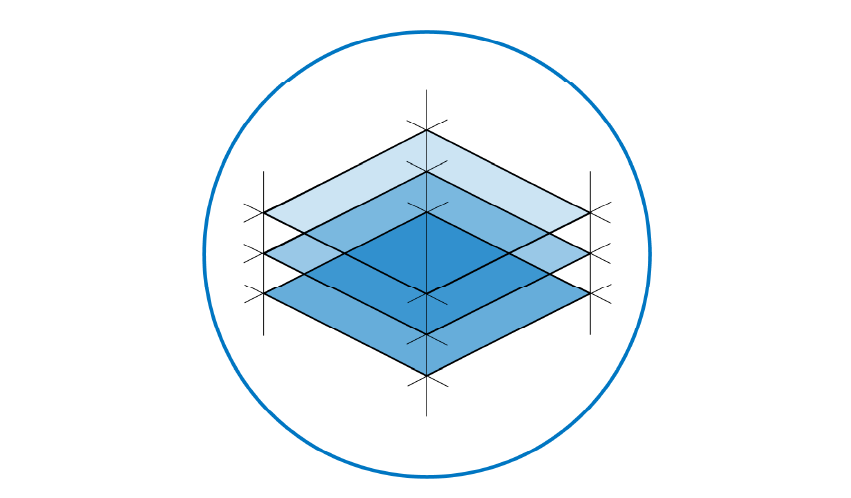10.9. Moment normal force interaction#
In this section calculations in which a normal force and moment are interacting with each other will be shown. The different points on the graph are calculated to give insight in the resistance of the columns. Initially, a setup with a bilinear \(\sigma\)-\(\varepsilon\) will be shown, which is relevant for the course Concrete & Steel Structures, which will include calculations. Then the interaction lines are plotted on the GTB tables, to show how they match. Secondly, a parabolic \(\sigma\)-\(\varepsilon\) will be shown and a corresponding normal force-moment interaction diagram from the GTB-tables will be given. Calculations will not be made on these interaction diagrams, as it is just for illustration purposes.
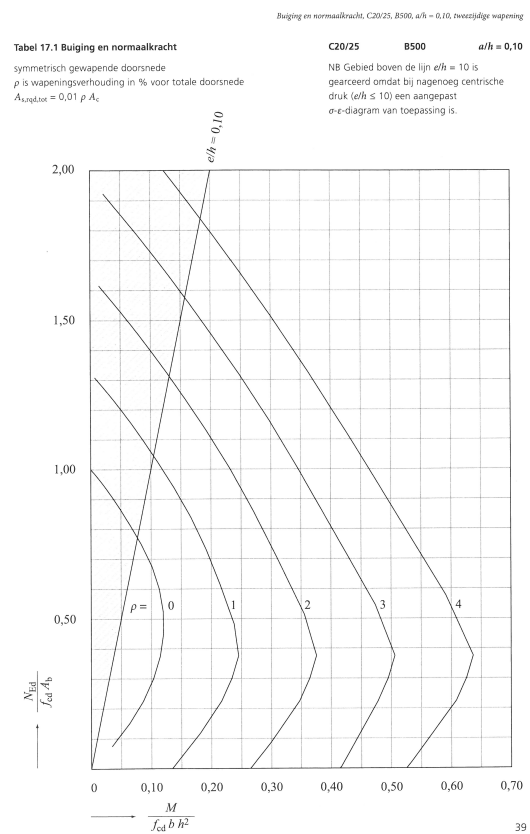
import numpy as np
import matplotlib.pyplot as plt
import matplotlib.image as mpimg
Example using linear-rectangle stress strain relations for concrete#
The following code shows an example that was part of an assignment for the BSc course Concrete & Steel Structures in the year 2023-2024, which has been slightly modified.
It assumes a linear \(\sigma\)-\(\varepsilon\) diagram.
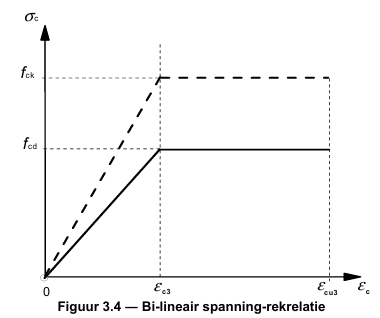
Fig. 10.48 Bi-linear \(\sigma\)-\(\varepsilon\) diagram#
The corner points of the Moment-Normal force have been calculated. Visually those are shown in. Also the situation for an tensile force and only a moment is added.
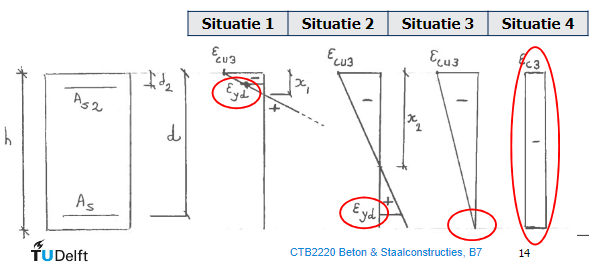
Fig. 10.49 4 grenssituaties#
Grenssituatie 0: zuivere buiging, geen normaalkracht#
def grenssituatie_0(c, phi_bgl, phi_hw, n_hw, f_yd, alfa, b, f_cd, h, beta):
"""
Calculate the design moment capacity (M_Rd0) and design axial force capacity (N_Rd0)
for a given concrete section with reinforcement.
Parameters:
c (float): Cover to reinforcement (mm)
phi_bgl (float): Diameter of the main longitudinal reinforcement (mm)
phi_hw (float): Diameter of the stirrups (shear reinforcement) (mm)
n_hw (int): Number of stirrups in the considered section
f_yd (float): Design yield strength of the reinforcement (N/mm^2)
alfa (float): Partial safety factor or strength reduction factor for concrete
b (float): Width of the concrete section (mm)
f_cd (float): Design compressive strength of concrete (N/mm^2)
h (float): Overall depth of the concrete section (mm)
beta (float): Factor accounting for the distribution of strains or stresses
Returns:
tuple: M_Rd0 (float), N_Rd0 (float)
"""
# Calculate intermediate values
a = c + phi_bgl + phi_hw / 2
A_s = 1 / 4 * np.pi * phi_hw ** 2 * n_hw
x_u0 = A_s * f_yd / (alfa * b * f_cd)
N_s_tension = A_s*f_yd
N_c = a*b * f_cd
N_s_compression = N_s_tension - N_c
# Calculate outputs
M_Rd0 = (N_s_tension * (h/2 - a) + N_c * (h/2 - a/2) + N_s_compression * (h/2 - a)) / 1e6
N_Rd0 = 0
return M_Rd0, N_Rd0
Grenssituatie 1: gedrukte wapening vloeit op druk, maximale betonstuik bereikt#
def grenssituatie_1(c, phi_bgl, phi_hw, n_hw, f_yd, alfa, b, f_cd, h, beta, eps_s, eps_cu3, E_s):
"""
Calculate the design moment capacity (M_Rd1) and design axial force capacity (N_Rd1)
for a given concrete section with reinforcement considering specific strain conditions.
Parameters:
c (float): Cover to reinforcement (mm)
phi_bgl (float): Diameter of the main longitudinal reinforcement (mm)
phi_hw (float): Diameter of the stirrups (shear reinforcement) (mm)
n_hw (int): Number of stirrups in the considered section
f_yd (float): Design yield strength of the reinforcement (N/mm^2)
alfa (float): Partial safety factor or strength reduction factor for concrete
b (float): Width of the concrete section (mm)
f_cd (float): Design compressive strength of concrete (N/mm^2)
h (float): Overall depth of the concrete section (mm)
beta (float): Factor accounting for the distribution of strains or stresses
eps_s (float): Strain in the reinforcement
eps_cu3 (float): Ultimate strain in the concrete
E_s (float): Modulus of elasticity of the reinforcement (N/mm^2)
Returns:
tuple: M_Rd1 (float), N_Rd1 (float)
"""
# Calculate intermediate values
a = c + phi_bgl + phi_hw / 2
A_s = 1 / 4 * np.pi * phi_hw ** 2 * n_hw
x_u1 = a / (1 - eps_s / eps_cu3)
e_sc = e_st = h / 2 - a
eps_st1 = eps_s
eps_sc1 = eps_s
N_st1 = N_sc1 = E_s * eps_st1 * A_s
N_c1 = alfa * b * f_cd * x_u1
eps_c1 = h / 2 - beta * x_u1
# Calculate outputs
M_Rd1 = (N_st1 * e_st + N_sc1 * e_sc + N_c1 * eps_c1) / 1e6 # kNm
N_Rd1 = (- N_st1 + N_sc1 + N_c1) / 1e3 # kN
return M_Rd1, N_Rd1
Grenssituatie 2: Getrokken wapening vloeit op trek, maximale betonstuik bereikt#
def grenssituatie_2(c, phi_bgl, phi_hw, n_hw, f_yd, alfa, b, f_cd, h, beta, eps_s, eps_cu3, E_s):
"""
Calculate the design moment capacity (M_Rd2) and design axial force capacity (N_Rd2)
for a given concrete section with reinforcement considering specific strain conditions.
Parameters:
c (float): Cover to reinforcement (mm)
phi_bgl (float): Diameter of the main longitudinal reinforcement (mm)
phi_hw (float): Diameter of the stirrups (shear reinforcement) (mm)
n_hw (int): Number of stirrups in the considered section
f_yd (float): Design yield strength of the reinforcement (N/mm^2)
alfa (float): Partial safety factor or strength reduction factor for concrete
b (float): Width of the concrete section (mm)
f_cd (float): Design compressive strength of concrete (N/mm^2)
h (float): Overall depth of the concrete section (mm)
beta (float): Factor accounting for the distribution of strains or stresses
eps_s (float): Strain in the reinforcement
eps_cu3 (float): Ultimate strain in the concrete
E_s (float): Modulus of elasticity of the reinforcement (N/mm^2)
Returns:
tuple: M_Rd2 (float), N_Rd2 (float)
"""
# Calculate intermediate values
a = c + phi_bgl + phi_hw / 2
A_s = 1 / 4 * np.pi * phi_hw ** 2 * n_hw
x_u2 = eps_cu3 * (h - a) / (eps_s + eps_cu3)
e_c2 = h / 2 - beta * x_u2
eps_st2 = eps_s
N_st2 = E_s * eps_st2 * A_s
eps_sc2 = min(eps_s, eps_cu3 * (x_u2 - a) / x_u2)
N_sc2 = E_s * eps_sc2 * A_s
N_c2 = alfa * b * f_cd * x_u2
# Calculate outputs
e_st = e_sc = h / 2 - a
M_Rd2 = (N_st2 * e_st + N_sc2 * e_sc + N_c2 * e_c2) / 1e6 # kNm
N_Rd2 = (- N_st2 + N_sc2 + N_c2) / 1e3 # kN
return M_Rd2, N_Rd2
Grenssituatie 3: maximale betonstuik bereikt, \(x_{u3} = h\).#
def grenssituatie_3(c, phi_bgl, phi_hw, n_hw, f_yd, alfa, b, f_cd, h, beta, eps_s, eps_cu3, E_s):
"""
Calculate the design moment capacity (M_Rd3) and design axial force capacity (N_Rd3)
for a given concrete section with reinforcement considering specific strain conditions.
Parameters:
c (float): Cover to reinforcement (mm)
phi_bgl (float): Diameter of the main longitudinal reinforcement (mm)
phi_hw (float): Diameter of the stirrups (shear reinforcement) (mm)
n_hw (int): Number of stirrups in the considered section
f_yd (float): Design yield strength of the reinforcement (N/mm^2)
alfa (float): Partial safety factor or strength reduction factor for concrete
b (float): Width of the concrete section (mm)
f_cd (float): Design compressive strength of concrete (N/mm^2)
h (float): Overall depth of the concrete section (mm)
beta (float): Factor accounting for the distribution of strains or stresses
eps_s (float): Strain in the reinforcement
eps_cu3 (float): Ultimate strain in the concrete
E_s (float): Modulus of elasticity of the reinforcement (N/mm^2)
Returns:
tuple: M_Rd3 (float), N_Rd3 (float)
"""
# Calculate intermediate values
a = c + phi_bgl + phi_hw / 2
A_s = 1 / 4 * np.pi * phi_hw ** 2 * n_hw
x_u3 = h
e_c3 = h / 2 - beta * x_u3
eps_st3 = min(eps_s, (eps_cu3 * a) / x_u3)
N_st3 = E_s * eps_st3 * A_s
eps_sc3 = min(eps_s, eps_cu3 * (x_u3 - a) / x_u3)
N_sc3 = E_s * eps_sc3 * A_s
N_c3 = alfa * b * f_cd * x_u3
# Calculate outputs
e_st = e_sc = h / 2 - a
M_Rd3 = (-N_st3 * e_st + N_sc3 * e_sc + N_c3 * e_c3) / 1e6 # kNm
N_Rd3 = (N_st3 + N_sc3 + N_c3) / 1e3 # kN
return M_Rd3, N_Rd3
Grenssituatie 4: centrische druk (geen momentcapaciteit)#
def grenssituatie_4(c, phi_bgl, phi_hw, n_hw, f_yd, alfa, b, f_cd, h, beta, eps_s, eps_cu3, E_s):
"""
Calculate the design moment capacity (M_Rd4) and design axial force capacity (N_Rd4)
for a given concrete section with reinforcement considering specific strain conditions.
Parameters:
c (float): Cover to reinforcement (mm)
phi_bgl (float): Diameter of the main longitudinal reinforcement (mm)
phi_hw (float): Diameter of the stirrups (shear reinforcement) (mm)
n_hw (int): Number of stirrups in the considered section
f_yd (float): Design yield strength of the reinforcement (N/mm^2)
alfa (float): Partial safety factor or strength reduction factor for concrete
b (float): Width of the concrete section (mm)
f_cd (float): Design compressive strength of concrete (N/mm^2)
h (float): Overall depth of the concrete section (mm)
beta (float): Factor accounting for the distribution of strains or stresses
eps_s (float): Strain in the reinforcement
eps_cu3 (float): Ultimate strain in the concrete
E_s (float): Modulus of elasticity of the reinforcement (N/mm^2)
Returns:
tuple: M_Rd4 (float), N_Rd4 (float)
"""
# Calculate intermediate values
a = c + phi_bgl + phi_hw / 2
A_s = 1 / 4 * np.pi * phi_hw ** 2 * n_hw
N_sc4 = E_s * eps_s * A_s
N_st4 = N_sc4
N_c4 = b * f_cd * h
# Calculate outputs
M_Rd4 = 0 # kNm
N_Rd4 = (N_st4 + N_sc4 + N_c4) / 1e3 # kN
return M_Rd4, N_Rd4
Grenssituatie -1: centrische trek (geen momentcapaciteit)#
def grenssituatie_min1(c, phi_bgl, phi_hw, n_hw, f_yd, alfa, b, f_cd, h, beta, eps_s, eps_cu3, E_s):
"""
Calculate the design moment capacity (M_Rd_1) and design axial force capacity (N_Rd_1)
for a given concrete section with reinforcement considering specific strain conditions.
Parameters:
c (float): Cover to reinforcement (mm)
phi_bgl (float): Diameter of the main longitudinal reinforcement (mm)
phi_hw (float): Diameter of the stirrups (shear reinforcement) (mm)
n_hw (int): Number of stirrups in the considered section
f_yd (float): Design yield strength of the reinforcement (N/mm^2)
alfa (float): Partial safety factor or strength reduction factor for concrete
b (float): Width of the concrete section (mm)
f_cd (float): Design compressive strength of concrete (N/mm^2)
h (float): Overall depth of the concrete section (mm)
beta (float): Factor accounting for the distribution of strains or stresses
eps_s (float): Strain in the reinforcement
eps_cu3 (float): Ultimate strain in the concrete
E_s (float): Modulus of elasticity of the reinforcement (N/mm^2)
Returns:
tuple: M_Rd_1 (float), N_Rd_1 (float)
"""
# Calculate intermediate values
A_s = 1 / 4 * np.pi * phi_hw ** 2 * n_hw
N_sc_1 = E_s * eps_s * A_s
N_st_1 = N_sc_1
N_c_1 = 0
# Calculate outputs
M_Rd_1 = 0 # kNm
N_Rd_1 = (-N_st_1 + -N_sc_1 + N_c_1) / 1e3 # kN
return M_Rd_1, N_Rd_1
Combining all in 1 function#
def MN_values(c, phi_bgl, phi_hw, n_hw, f_yd, alfa, b, f_cd, h, beta, eps_s, eps_cu3, E_s):
A_s = 1 / 4 * np.pi * phi_hw ** 2 * n_hw
rho = 2*A_s / (b*h)
a = c + phi_bgl + phi_hw / 2
a_over_h = a/h
M_Rd0, N_Rd0 = grenssituatie_0(c, phi_bgl, phi_hw, n_hw, f_yd, alfa, b, f_cd, h, beta)
M_Rd1, N_Rd1 = grenssituatie_1(c, phi_bgl, phi_hw, n_hw, f_yd, alfa, b, f_cd, h, beta, eps_s, eps_cu3, E_s)
M_Rd2, N_Rd2 = grenssituatie_2(c, phi_bgl, phi_hw, n_hw, f_yd, alfa, b, f_cd, h, beta, eps_s, eps_cu3, E_s)
M_Rd3, N_Rd3 = grenssituatie_3(c, phi_bgl, phi_hw, n_hw, f_yd, alfa, b, f_cd, h, beta, eps_s, eps_cu3, E_s)
M_Rd4, N_Rd4 = grenssituatie_4(c, phi_bgl, phi_hw, n_hw, f_yd, alfa, b, f_cd, h, beta, eps_s, eps_cu3, E_s)
M_Rd_1, N_Rd_1 = grenssituatie_min1(c, phi_bgl, phi_hw, n_hw, f_yd, alfa, b, f_cd, h, beta, eps_s, eps_cu3, E_s)
M_Rd = np.array([M_Rd_1, M_Rd0, M_Rd1, M_Rd2, M_Rd3, M_Rd4])
N_Rd = np.array([N_Rd_1, N_Rd0, N_Rd1, N_Rd2, N_Rd3, N_Rd4])
return M_Rd, N_Rd, rho, a_over_h
Diagram#
With all the functions defined above we can create the M-N interaction diagram. We therefore need to define some input to obtain a proper output.
f_ck = 20 #[N/mm^2] C20/25
f_cd = f_ck/1.5
alfa = 0.75
beta = 7/18
eps_cu3 = 0.0035
f_yk = 500 #[N/mm^2] B500B
f_yd = f_yk/1.15
eps_s = 0.002175
c = 13 #[mm]
phi_bgl = 6 #[mm]
n_hw = 4 #[-] aantal staven
phi_hw = 12 #[mm]
E_s = 200000 #[N/mm^2]
b = 250 #[mm]
h = 250 #[mm]
M_Rd, N_Rd, rho, a_over_h = MN_values(c, phi_bgl, phi_hw, n_hw, f_yd, alfa, b, f_cd, h, beta, eps_s, eps_cu3, E_s)
plt.plot(M_Rd, N_Rd)
for i in range(len(M_Rd)):
plt.plot(M_Rd[i], N_Rd[i], marker='x', linestyle='', label =f'Grenssituatie {i-1}')
plt.title(f'Moment normal force interaction rho = {rho:.2%}')
plt.xlabel('M_Rd [kNm]')
plt.ylabel('N_Rd [kN]')
plt.legend()
plt.grid()
# Show the plot
plt.show();
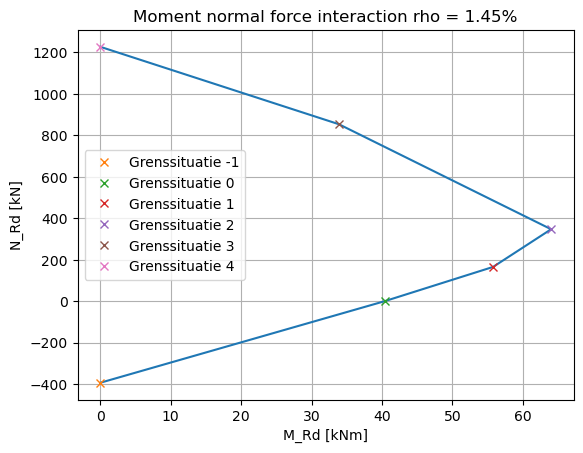
The function can also be used to obtain the multiple lines in the graph with the function that has been used below. It can be seen that they match nicely.
Note
In order not to change the \(\frac{a}{h}\) ratio, whilst increasing the reinforcement ratio \(\rho\), the number of bars \(n_{hw}\) is altered. Note that actually it is not feasible to have a non-integer value of bars, but for the purpose of this diagram this modification is very useful.
n_hw_list = np.array([n_hw/1.4475, n_hw/1.4475*2, n_hw/1.4475*3, n_hw/1.4475*4])
# Load the background image
table_image = mpimg.imread('Images/GTB_table2008_bilinear.png')
# Create a figure
fig, ax = plt.subplots(figsize=(10, 12))
# Display the background image
y_llim = -0.22
y_ulim = 2.57
ax.imshow(table_image, extent=[-0.15, 0.73, y_llim, y_ulim], aspect='auto')
plt.title('Moment normal force interaction')
# Create and plot the different lines
for i in range(len(n_hw_list)):
M_Rd, N_Rd, rho, a_over_h = MN_values(c, phi_bgl, phi_hw, n_hw_list[i], f_yd, alfa, b, f_cd, h, beta, eps_s, eps_cu3, E_s)
x_values = M_Rd*1e6/(f_cd * b*h)*(1/h)
y_values = N_Rd*1e3/(f_cd * b*h)
ax.plot(x_values, y_values, label =f'rho = {rho:.2%}')
plt.xlabel(r'$\frac{N_{Ed}}{f_{cd} \cdot A_c} \cdot \frac{e}{h}$')
plt.ylabel(r'$\frac{N_{Ed}}{f_{cd} \cdot A_c}$')
plt.ylim(y_llim, y_ulim)
plt.legend()
plt.grid()
# Show the plot
plt.show();
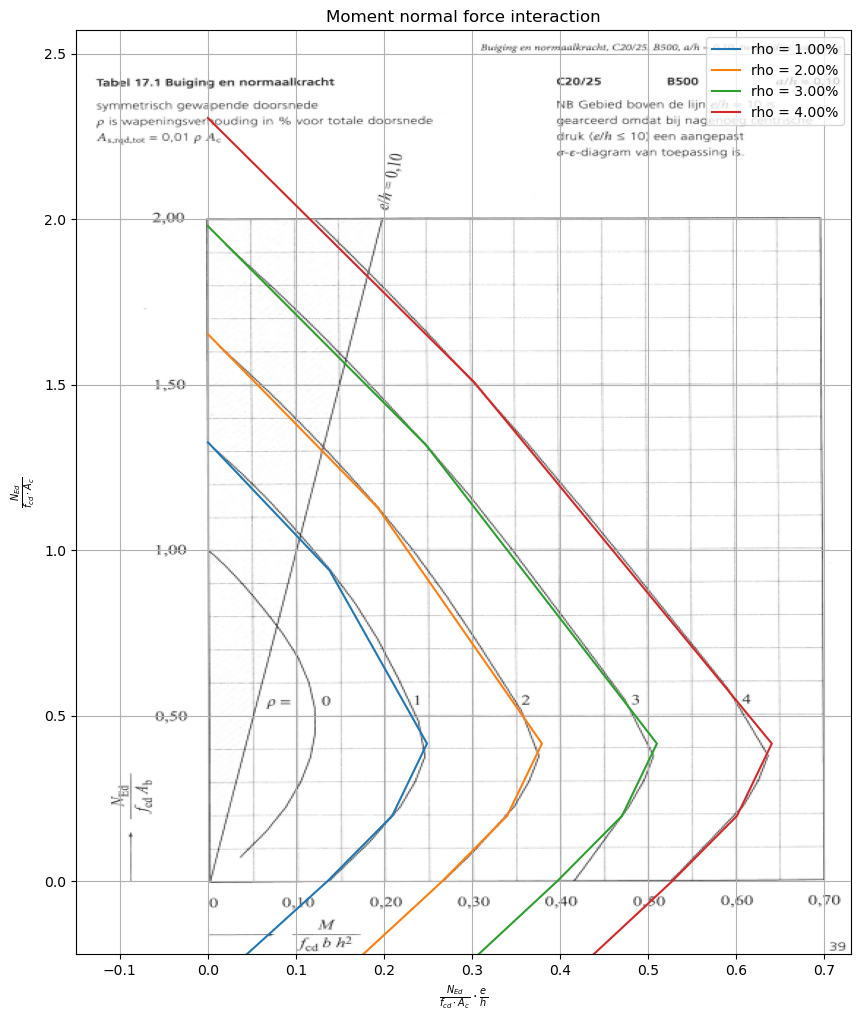
Example using parabola-rectangle stress strain relations for concrete#
According to EC2 stress in the concrete can be calculated using the formula:
\( \sigma_c = f_{cd}[1-(1-\frac{\varepsilon_c}{\varepsilon_c2})^{n}] \) for \(0 \leq \varepsilon_c \leq \varepsilon_{c2}\)
\( \sigma_c = f_{cd} \) for \( \varepsilon_{c2} \leq \varepsilon_c \leq \varepsilon_{cu2}\)
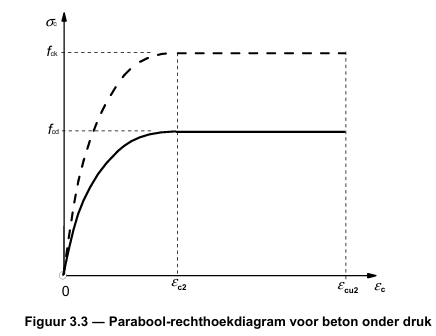
Fig. 10.50 Parabola-rectangle \(\sigma\)-\(\varepsilon\) diagram#
The following assumptions are used…
De grafieken zijn gebaseerd op EC2, 6.1 en 3.1.7(1), hetgeen inhoudt dat er is gerekend met het parabool-rechthoek spanning-rek-diagram.
Er is geen gebruikgemaakt van het sterkte-verhogende effect van omsluiting van het beton door de beugels volgens EC2, 3.1.9(2).
Ingevolge EC2, 6.1(5) moet de gemiddelde stuik worden beperkt, waardoor bij vrijwel centrische druk geen vloei van het staal optreedt, immers \( \varepsilon_{c2} < \varepsilon_{sy}\).
Omdat, gezien EC2, 6.1(4) \(\frac{e}{h}\) nooit kleiner mag zijn dan 1/30 is de top van de figuur afgekapt met de horizontale lijn waar de bezwijkcontour de diagonaal \( \frac{e}{h} = \frac{1}{3}\) snijdt.
\( e = \frac{M_{Ed}}{N_{Ed}}\), waarin \(M_{Ed}\) de rekenwaarde is van het buigend moment, inclusief het tweede-orde moment.
Voor de grafieken tot en met C45/55 wordt de mechanische wapeningsverhouding \(\rho \cdot \frac{f_{yd}}{f_cd}\) afgelezen, waaruit \(\rho\) te bepalen is. Voor de grafieken vanaf C55/67 wordt de wapeningsverhouding \(\rho\) direct afgelezen.
In de koptekst op de navolgende bladen is 0.10 en 0.15 steeds de \(\frac{a}{h}\) waarde.
The GTB-table is now given for the parabola-rectangle relationships below. The plotted line on top of it is a line calculated with the bi-linear stress strain relations.
M_Rd, N_Rd, rho, a_over_h = MN_values(c, phi_bgl, phi_hw, n_hw, f_yd, alfa, b, f_cd, h, beta, eps_s, eps_cu3, E_s)
print('Look in the graph at approximately the following line:')
print(f'{rho*f_yd/f_cd:.2f} = rho * f_yd/f_cd')
x_values = M_Rd*1e6/(f_cd * b*h)*(1/h)
y_values = N_Rd*1e3/(f_cd * b*h)
# Load the background image
table_image = mpimg.imread('Images/Reinforcement_Table1.jpg')
# Create a figure
fig, ax = plt.subplots(figsize=(10, 12))
# Display the background image
ax.imshow(table_image, extent=[-0.125, 1.025, -0.58, 2.90], aspect='auto')
plt.title('Moment normal force interaction')
ax.plot(x_values, y_values)
for i in range(len(M_Rd)):
ax.plot(x_values[i], y_values[i], marker='x', linestyle='', label =f'Grenssituatie {i-1}')
plt.xlabel(r'$\frac{N_{Ed}}{f_{cd} \cdot A_c} \cdot \frac{e}{h}$')
plt.ylabel(r'$\frac{N_{Ed}}{f_{cd} \cdot A_c}$')
plt.legend()
plt.grid()
# Show the plot
plt.show();
Look in the graph at approximately the following line:
0.47 = rho * f_yd/f_cd
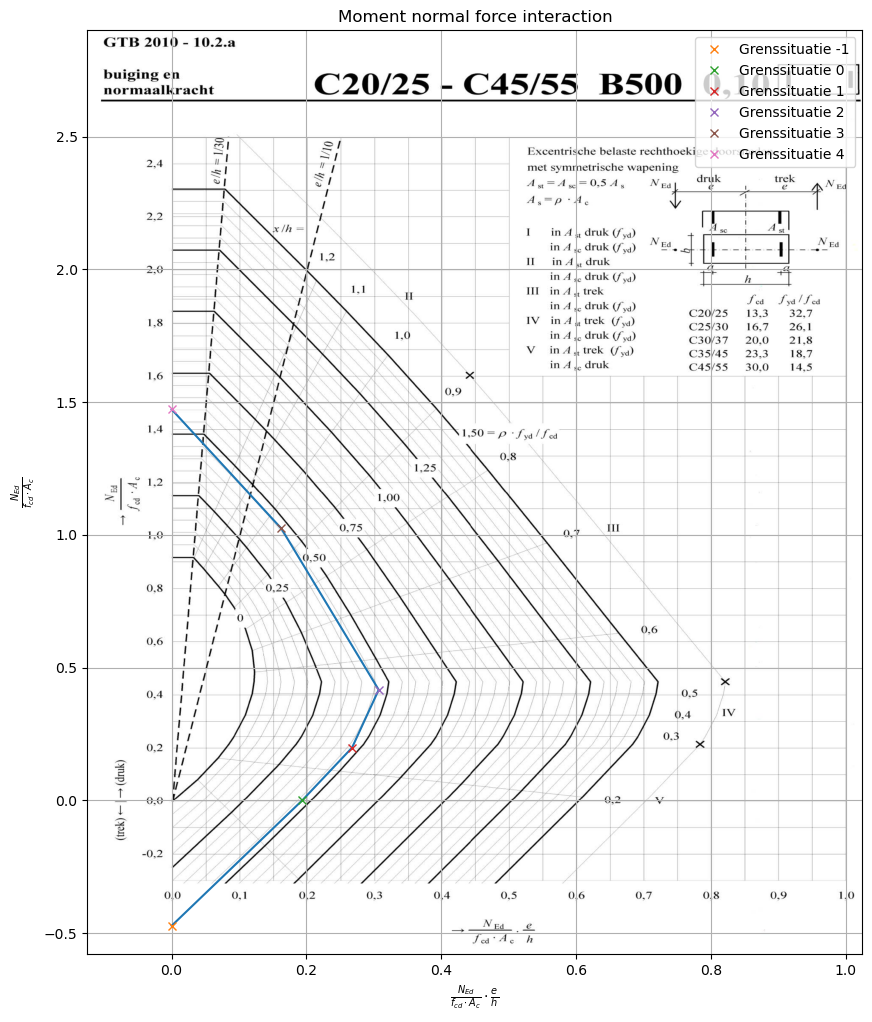
Do you see…
… that only sleight differences occur between the bi-linear and parabola-rectangle diagram.
… that situation 4 (only compression) is not matching well? This is because of buckling that is considered in the GTB-tables, but not in our calculations. Buckling does of course not happen on the tension side.
